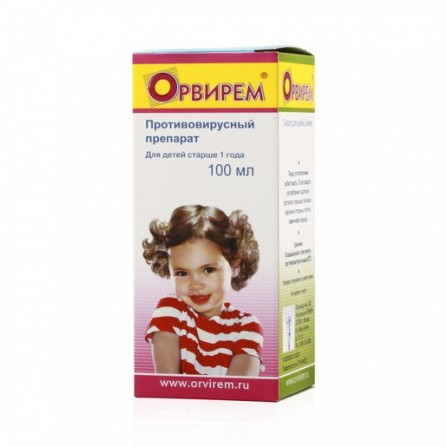Orvirem (rimantadine) syrup for children 0.2% 100ml
Condition: New product
1000 Items
Rating:
Be the first to write a review!

More info
Active ingredients
Rimantadine
Release form
Syrup
Composition
1 ml of syrup (5 ml (1 tea.l)) contains: Active substance: rimantadine hydrochloride 2 mg (10 mg). Auxiliary substances: sugar, sodium alginate, dye E122, purified water.
Pharmacological effect
Antiviral drug. Rimantadine is an adamantane derivative; active against various strains of influenza A virus (especially type A2). Being a weak base, rimantadine acts by raising the pH of endosomes, which have a membrane of vacuoles and surrounding viral particles after they enter the cell. The prevention of acidification in these vacuoles blocks the fusion of the viral envelope with the membrane of the endosome, thus preventing the transfer of viral genetic material into the cytoplasm of the cell. Rimantadine also inhibits the release of viral particles from the cell, i.e. interrupts the transcription of the viral genome. The appointment of rimantadine within 2-3 days before and 6-7 hours after the onset of clinical manifestations of influenza type A reduces the incidence, the severity of symptoms and the degree of serological reaction. Some therapeutic effects may also occur if rimantadine is prescribed within 18 hours after the first symptoms of influenza occur.
Pharmacokinetics
After ingestion, rimantadine is almost completely absorbed in the intestine. Absorption is slow. Plasma rimantadine Cmax when taking a dose of 100 mg 1 time / day is 181 ng / ml, 100 mg 2 times / day - 416 ng / ml. Distribution Plasma protein binding is about 40%. Vd in adults - 17-25 l / kg, in children - 289 l / kg. Concentration in the nasal secretion is 50% higher than in the blood plasma. Metabolism and excretion Metabolized in the liver. T1 / 2 - 24-36 h; excreted by the kidneys 15% - unchanged, 20% - in the form of hydroxyl metabolites. Pharmacokinetics in special clinical situations With chronic renal failure, T1 / 2 increases by 2 times. In patients with renal insufficiency and in elderly patients, it can accumulate in toxic concentrations if the dose is not adjusted in proportion to the decrease in creatinine clearance.
Indications
Prevention and early treatment of influenza A in children over 1 year old. Rimantadine prophylaxis can be effective in contacts with patients at home, with the infection spreading in closed collectives and at high risk of developing a disease during a flu epidemic.
Contraindications
acute liver disease; acute and chronic kidney disease; thyrotoxicosis; pregnancy; lactation period; children up to 1 year; hypersensitivity to the drug. Precautions should be prescribed the drug for epilepsy (including in history).
Precautionary measures
Application for violations of the liver, contraindicated in acute liver diseases. Application for violations of renal function. Contraindicated in acute and chronic diseases of the kidneys.
Use during pregnancy and lactation
The drug is contraindicated for use during pregnancy and lactation.
Dosage and administration
When treating the drug, Orvirem is taken orally (after eating) with water, according to the following scheme: - for children from 1 to 3 years - on day 1 10 ml (2 teaspoons) of syrup (20 mg) 3 times / day . (daily dose - 60 mg); in the 2nd and 3rd days - 10 ml 2 times / day. (daily dose - 40 mg), on the 4th day - 10 ml 1 time / day. (daily dose of 20 mg); - for children from 3 to 7 years old - on the 1st day -15 ml (3 teaspoons) of syrup (30 mg) 3 times / day. (daily dose - 90 mg); in the 2nd and 3rd days - 3 teaspoons 2 times / day. (daily dose - 60 mg), on the 4th day - 3 teaspoons 1 time / day. (daily dose - 30 mg). For prevention, Orvirem is prescribed: - for children from 1 year to 3 years - 10 ml (2 teaspoons) of syrup (20 mg) 1 time / day; - children from 3 to 7 years old - 15 ml (3 teaspoons) of syrup (30 mg) 1 time / day. within 10-15 days depending on the source of infection. The daily dose of rimantadine should not exceed 5 mg / kg body weight.
Side effects
The drug is usually well tolerated. The following adverse reactions are sometimes observed. On the part of the digestive system: nausea, vomiting, epigastric pain, flatulence, anorexia. From the side of the central nervous system: headache, dizziness, insomnia, neurological reactions, impaired concentration. Other: hyperbilirubinemia, allergic reactions (skin rash, itching, urticaria), asthenia.
Overdose
Cases of overdose so far not identified.
Interaction with other drugs
When combined, Orvirem reduces the effectiveness of anti-epileptic drugs. When taken simultaneously, adsorbents, binders and coating agents reduce the absorption of rimantadine. Drugs, acidifying urine (acetazolamide, sodium bicarbonate), increase the effectiveness of rimantadine due to the reduction of its excretion by the kidneys.When combined with the use of acetylsalicylic acid, paracetamol reduce the Cmax value of rimantadine by 11%. Cimetidine reduces the clearance of rimantadine by 18%.
special instructions
While taking the drug may exacerbate chronic comorbidities. When epilepsy increases the risk of developing an epileptic seizure. Syrup contains 60% sucrose, which should be considered when prescribing the drug to patients with diabetes mellitus. Perhaps the emergence of drug-resistant viruses.




